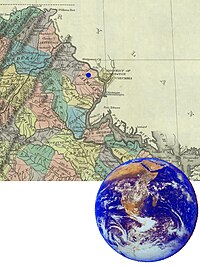CDT: Lets Make a Map of Wikipedia
The concept of Wikipedia is tremendous. Never before in human history has it ever been possible to collectively define our knowledge and expertise through such a widely shared dialogue. If it was a party, the roar would be deafening. The problem is, we know so much. And, we often know similar ideas from different perspectives. Even an expert in an obscure discipline can never keep up with all of the literature, data, and points of view that have become available and it's only getting worse. There simply is not enough time in a human lifespan to see or consider it all.

CDT stands for Context Driven Topologies, an open source system of mathematical mapping, audio-visual presentation, and data structures to serve as a bridge between interactive thinking communities like Wikipedia, large scale digital collections and archives, and everyone with a computer.
CDT is a process for packing and unpacking digital information by priorities and themes. The system proposed is used to assemble interactive exhibits of thought provoking ideas and information in various levels of detail and "edit-ability". Fine tuning CDT exhibits and themes over time is intended to serve as a discussion tool for the general public to let research scientists, artists, funding agencies and governments know which topics they are most curious about and interested in. CDT tracks where questions, answers, and ideas are coming from to start narrowing down the answers and best examples to make them easier to find. This will allow us to consolidate the necessary resources to care for and maintain fewer higher quality materials rather than feeling like we are drowning in information like we are today. There actually are many, many topics and processes where all kinds of people from different cultural and intellectual backgrounds can agree that one answer, method, sequence and pace for presentation and learning is known work best or be the most appealing to the greatest numbers of people. The following software will be used. Interoperability standards, specific hardware, and internet requirements are being investigated.
AutoCAD2007(Drawing).dwg, .tiff 2 GB RAM or greater Revit (3D Model) 4.86 GB free disk space
ArcEditor GIS (Geographic Mapping) .mxd, .jpg 256 RAM or greater, 800 MHz processor
MATLAB (Flow, Time, and System Representation).mex, nfts, fat 1024 MB RAM, 460 MB disk space
MrSID (Image Compression).sid, .tif 1 GB/2 GB RAM GeoExpress
Photoshop 7 (Images & Illustration) .jpg, .tiff 384MB RAM,650MB disk space
ColdFusion MX 7 Web Development 512 MB RAM, 500 MB disk space
All require: Microsoft Windows 2000 Advanced Server, Datacenter Server, Server (SP3 and higher); Windows XP Professional SP2; Intel® Pentium® 4 or AMD-K7™ processor, 3 GHz or higher; 128 MB or greater, OpenGL®-capable graphics card; 1280x1024 32-bit color video display adapter (true color); Sound card; Modem with high speed connection; TCP/IP or IPX support.

The information itself for CDT (currently files) resides in archives, individual computers, and shared networks all around the world. Some of these collections are public, some are private, most are a mix of both. One problem with digital collections today versus "real" collections like art objects we have always had is that too many low resolution copies of the same item exist; CDT is used to streamline redundant copies down to one high quality original surrounded by sets of carefully mapped references.
CDT works both from the bottom up and the top down by collecting and comparing changes as exhibits are assembled and reassembled over time. IE: sets of questions with more and more streamlined references leading to narrowed down sets of answers and explanations. The dynamic records created by CDT continually evolve and improve with humanity's collective knowledge and expertise. Everyone, both experts and novices alike can contribute to and learn from this system.
Today, CDT would be primarily accessible through gatekeepers and battle zones like Wikipedia. It should be as easy to use as a tv clicker with much more interesting content being played for you. Eventually the aim is for CDT to be used to manage digital archives and information services, and as a tool for individuals and groups to publish and protect their work in context. Our definition of context is precise combinations of geography, knowledge domain, and internet addresses. The CDT format and presentation mode will allow digital recordings, high resolution images, and interactive visualizations to be located and shown via Wikipedia and other open sources for research and educational purposes. The experts themselves in any given area would hash it out over which materials best illustrate and/or serve as an index on any given topic. Simply seeing where the experts do not agree tells a story by itself. CDT generates maps and graphics to show simplified overviews of these processes with linkages back to the publications and arguments that back it up.
We, the 501(c)(3) nonprofit organization Accuracy&Aesthetics [1] based in Vienna VA, are currently seeking tax deductible contributions for a CDT model demonstration project. The project participants are a group of curators, engineers, research scientists, artists, and integrators from disciplines and cultures around the world [www.contextdriventopology.org]. Our current objective is to build a small network of ten art museums, ten scientific research institutes, and ten new media/new technology efforts in ten cities around the world. Come join us. Results from the CDT model demonstration project will be published through a variety of modes and media including traveling exhibits; discussions, lectures, and workshops in person and online; technical and artistic conferences and journals; and web based interactives.
For more information, please contact Accuracy&Aesthetics projects director Deborah MacPherson at: PO Box 52, Vienna VA 22183 or deborah.macpherson@cox.net -or- donate online at Network for Good: [2]